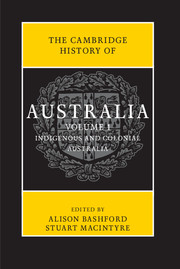Book contents
- Frontmatter
- Contents
- Abbreviations
- List of maps
- List of figures
- List of tables
- Notes on contributors
- Map
- Preface
- Introduction
- PART I
- PART II
- 11 Environmental transformations
- 12 Population and health
- 13 The economy
- 14 Indigenous and settler relations
- 15 Education
- 16 Law and regulation
- 17 Religion
- 18 Colonial science and technology
- 19 Gender and colonial society
- 20 Art and literature: a cosmopolitan culture
- 21 Empire: Australia and ‘Greater Britain’, 1788–1901
- 22 Colonial Australia and the Asia-Pacific region
- 23 The Australian colonies in a maritime world
- Further reading
- Chronology
- Index
- Frontmatter
- Contents
- Abbreviations
- List of maps
- List of figures
- List of tables
- Notes on contributors
- Map
- Preface
- Introduction
- PART I
- PART II
- Further reading
- Chronology
- Index
14 - Indigenous and settler relations
from PART II
Published online by Cambridge University Press: 05 November 2013
- Frontmatter
- Contents
- Abbreviations
- List of maps
- List of figures
- List of tables
- Notes on contributors
- Map
- Preface
- Introduction
- PART I
- PART II
- 11 Environmental transformations
- 12 Population and health
- 13 The economy
- 14 Indigenous and settler relations
- 15 Education
- 16 Law and regulation
- 17 Religion
- 18 Colonial science and technology
- 19 Gender and colonial society
- 20 Art and literature: a cosmopolitan culture
- 21 Empire: Australia and ‘Greater Britain’, 1788–1901
- 22 Colonial Australia and the Asia-Pacific region
- 23 The Australian colonies in a maritime world
- Further reading
- Chronology
- Index
- Frontmatter
- Contents
- Abbreviations
- List of maps
- List of figures
- List of tables
- Notes on contributors
- Map
- Preface
- Introduction
- PART I
- PART II
- Further reading
- Chronology
- Index
Summary
At the close of the eighteenth century, contact between Aboriginal people and Europeans was localised along coastal regions of the continent. Penal settlements at Port Jackson and in Van Diemen's Land sat at the edge of vast Aboriginal worlds. The crown's Instructions to Governor Phillip were to ‘endeavour by every possible means to open an Intercourse with the Natives and to conciliate their affections’, ‘to live in amity and kindness with them’, and to ‘punish’ those who would ‘wantonly destroy them’. But small British military garrisons and coastal settlements were unstable contact zones in which rituals of diplomacy could mix easily with aggression. Contact, conciliation and conflict would always be closely intertwined.
Newcomers often depended on Indigenous knowledge for their survival. Acts of curiosity, accord and handshakes could be performed by British and Aboriginal people and then followed swiftly by ritualised acts of judicial violence: a highly choreographed British hanging, for example, or a closely sequenced Aboriginal spearing. In the early years, when debates over the reach of British sovereignty were in flux, the British responded to conflict with Aboriginal people in localised and disparate ways, and it was nearly half a century before the authority claimed by the British crown was settled legal doctrine.
Aboriginal people experienced the arrival of British colonists as an invasion. First contact was accompanied by the transmission of new diseases, which travelled ahead of the physical frontier along Indigenous trading and cultural networks. In 1789 smallpox devastated Aboriginal populations in the Port Jackson, Botany Bay and Broken Bay regions. Some scholars estimate that up to 80 per cent of the population died in the Sydney region, causing massive social and cultural disruption. Smallpox spread inland and later moved along river systems, decimating networks of people on the Murray and Darling rivers.
- Type
- Chapter
- Information
- The Cambridge History of Australia , pp. 342 - 366Publisher: Cambridge University PressPrint publication year: 2013
- 3
- Cited by



